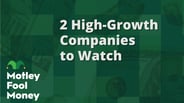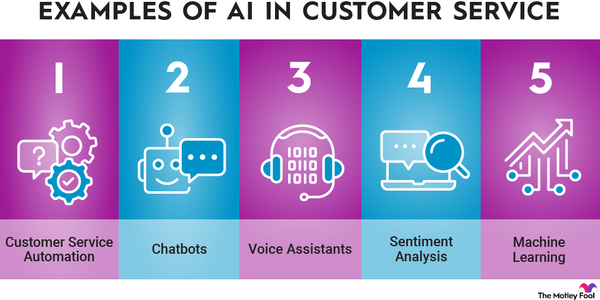Nvidia (NVDA 1.89%) launched 30 years ago with a simple vision: Its founders wanted the gaming and multimedia markets to experience the power of 3D graphics. A few years later, the company revolutionized the computer industry by inventing the first graphics processing unit (GPU).
Nvidia has had a long history of innovation since developing the GPU. Today, the semiconductor company develops and manufactures processors vital for data centers, cloud-based platforms, gaming, automobiles, and artificial intelligence (AI).
The company's latest innovation is accelerated computing. Nvidia pioneered the technology, which uses specialized hardware to speed up work significantly. It will often use parallel processing to bundle recurring tasks.
Semiconductor
The company believes accelerated computing can help unlock the power of AI. Nvidia's GPUs power the AI software behind OpenAI's wildly popular ChatGPT program.
Fellow tech behemoth Microsoft (MSFT -4.3%) is investing billions of dollars into OpenAI to help take the technology to the next level, which should drive strong demand for Nvidia's processors. That has certainly been the case in 2023 as its AI-related chip sales soared.
Accelerated computing is also helping re-accelerate Nvidia's profits, boosting the company's stock price and making it a potentially excellent long-term investment. Here's a step-by-step guide on buying Nvidia shares and some factors to consider before investing in the technology stock.
How to buy
How to buy Nvidia stock
You can buy shares of Nvidia in any brokerage account. If you still need to open one, these are some of the best-rated brokers and trading platforms. Here's a step-by-step guide to buying Nvidia stock using the five-star-rated platform Fidelity.
Fidelity makes it easy to buy stocks. Its website also offers a video tutorial and step-by-step guide. Here's a screenshot of how to place a stock trade via Fidelity:

On this page, fill in all the relevant information, including:
- The number of shares you want to buy or the amount you want to invest to purchase fractional shares.
- The ticker symbol (NVDA for Nvidia).
- Whether you want to place a limit order or a market order. The Motley Fool recommends using a market order because it guarantees you buy shares immediately at the current market price.
Once you complete the order page, click the Place Order button at the bottom and become a Nvidia shareholder.
Shareholder
Should I invest
Should I invest in Nvidia?
Before investing in Nvidia, you must determine whether Nvidia stock is a good one to buy. Here are some reasons you might consider investing in Nvidia stock:
- You want to invest in a company capitalizing on the long-term demand growth for computing power.
- You want to invest in a profitable and financially strong company.
- You use Nvidia's technology in gaming applications.
- You like the company's investments in providing solutions for exciting growth sectors like AI and autonomous vehicles.
- You believe Nvidia stock can outperform the S&P 500 over the long term.
- You think the company's accelerated computing strategy will drive profit growth in the coming years.
- You're confident the gaming market will bounce back from its post-pandemic lull.
- You believe Nvidia can continue to be an innovator.
- You don't rely on dividend income right now and are content with the company's small payment.
- You understand Nvidia's stock could be volatile and might lose value.
- You want to invest in a founder-led company and believe that co-founder and CEO Jensen Huang can continue growing shareholder value.
Conversely, here are some reasons you might decide Nvidia isn't the right stock for you:
- You're worried about the slowdown in tech-related spending and its potential effect on Nvidia's data center products.
- You don't understand what the company does or how it makes money.
- You're not sure the gaming market will recover.
- You're concerned about AI and unsure it will live up to the hype.
- You're looking for investments with lower volatility than Nvidia stock.
- You're seeking more dividend income than Nvidia currently provides.
Profitability
Is Nvidia profitable?
Profit growth helps drive stock price appreciation over the longer term, making Nvidia an ideal area for beginning investors to focus on before buying shares of any company. Nvidia is solidly profitable. The company generated almost $27 billion in revenue and produced $4.4 billion of net income in its 2023 fiscal year.
Revenue
While revenue from the previous year was flat, income decreased sharply (55%) from its 2022 fiscal year. Weighing on income were higher costs -- including increased spending on research and development -- and lower sales of higher-margin products to the gaming and cryptocurrency mining markets.
However, that trend, powered by AI, reversed in its 2024 fiscal year. Nvidia's revenue surged 206% in the third quarter to a record $18.1 billion, driven by record data center revenue of $14.5 billion, up 279% from a year ago. That helped drive a 12-fold increase in its earnings per share during the quarter. Nvidia's robust profit growth has been a major catalyst for its stock price:

Nvidia also generates lots of cash. The company produced $5.6 billion of cash from operations in its 2023 fiscal year and almost $3.8 billion of free cash flow.
That number ballooned to over $7 billion in its fiscal third quarter of 2024 as it cashed in on AI-driven chip demand. The cash flow gave it the funds to invest in continued innovation while returning money to shareholders through dividends and share repurchases.
Nvidia believes its investments in accelerated computing position it to capitalize on the explosive growth in AI. The company also expects the gaming market to recover from its post-pandemic slump. These catalysts have enabled Nvidia's profits to re-accelerate and could continue driving them higher.
Dividends
Does Nvidia pay a dividend?
Nvidia initiated a dividend in 2012. It had steadily increased its payout for the first several years after declaring its initial dividend.
Dividend Payments
However, as of late 2023, Nvidia hadn't increased its dividend in several years (and didn't plan to increase its payout in the coming year). With the dividend remaining static and the share price continuing to gain value, Nvidia's dividend yield has fallen over the years. It was minuscule in late 2023 (0.03% compared to 1.5% for the S&P 500).
Although Nvidia doesn't pay a big dividend, it returns significant cash to investors through share repurchases. The company returned $10.4 billion to investors in its 2023 fiscal year, paying $398 million in dividends and repurchasing more than $10 billion in stock. Meanwhile, the company added a massive $25 billion to its share repurchase program in 2023.
ETF options
ETFs with exposure to Nvidia
Instead of actively buying shares of Nvidia directly, you can passively invest in the technology company through a fund holding its shares. Nvidia is one of the largest companies in the world by market capitalization and is a widely held stock.
Nvidia is in several stock market indexes, including the S&P 500 and Nasdaq Composite Index. As a result, index funds and exchange-traded funds (ETFs) that benchmark their returns against those indexes hold Nvidia stock. According to ETF.com, 482 ETFs held 209 million shares of Nvidia as of late 2023. The ETFs with the most shares were:
| Exchange-traded fund | Assets Under Management | Nvidia Shares Held | Fund Weighting | Position Ranking in Fund |
|---|---|---|---|---|
| SPDR S&P 500 ETF Trust (NYSEMKT:SPY) | $442.1 billion | 28.4 million | 2.9% | fourth-largest |
| iShares Core S&P 500 (NYSEMKT:IVV) | $378.0 billion | 22.3 million | 2.9% | fourth-largest |
| Vanguard S&P 500 ETF (NYSEMKT:VOO) | $354.5 billion | 22.2 million | 2.9% | fourth-largest |
| Invesco QQQ Trust (NYSEMKT:QQQ) | $216.4 billion | 20.2 million | 4.2% | fourth-largest |
| Vanguard Total Stock Market ETF (NYSEMKT:VTI) | $328.7 billion | 17.1 million | 2.4% | fourth-largest |
Given its large market cap, Nvidia is among the top five holdings of the five largest ETFs by assets under management (AUM). The SPDR S&P 500 ETF owns the most shares and has a meaningful portfolio weighting among the biggest ETFs. That makes it a solid option for investors seeking exposure to Nvidia stock.
Several other ETFs offer greater exposure to Nvidia stock. The VanEck Semiconductor ETF (SMH 0.5%) is a reasonably large ETF with a higher portfolio weighting to Nvidia (19%), making it a possible alternative for investors seeking passive exposure to the stock.
Stock splits
Will Nvidia stock split?
As of late 2023, Nvidia hadn't announced an upcoming stock split. However, the company has completed several stock splits throughout its history:
| Split Date | Stock Split |
|---|---|
| July 2021 | 4-for-1 |
| September 2007 | 3-for-2 |
| April 2006 | 2-for-1 |
| September 2001 | 2-for-1 |
| June 2000 | 2-for-1 |
Nvidia's stock was more than $750 per share when it implemented its last split in 2021. In late 2023, the company's stock price was above $475 per share. Given that price point, it seems unlikely that the company will split its stock in the near future. Nvidia waited 14 years between stock splits last time and could let shares appreciate much more before splitting again.
Related investing topics
The bottom line on investing in Nvidia stock
Nvidia's continued innovation has helped drive the company's profit and stock price higher over the years. While prices hit a speed bump in its 2023 fiscal year, they've already started to reaccelerate. The company's investments in accelerated computing position it to capitalize on the enormous potential of AI, which could reignite its earnings and stock price, making Nvidia a great long-term investment.
FAQs
FAQs on investing in Nvidia stock
Can I invest in Nvidia stock?
Nvidia is a publicly traded company. Anyone with a brokerage account can invest in Nvidia stock.
Where can I invest in Nvidia?
You can invest in Nvidia through a brokerage account. It's easy to buy shares of Nvidia. Open and fund a brokerage account, fill out the order page, and submit the trade.
Is Nvidia a good investment?
Nvidia has been a very good investment over the years. As of late 2023, Nvidia has delivered a more than 62% average annual return to its investors over the last 10 years. That has significantly outperformed the S&P 500 (9.8% average annual return).
While that past outperformance is no guarantee of future success, Nvidia is in an excellent position to continue producing outsize returns. It's a leader in making semiconductors for AI, which is becoming a major growth driver for the company.
Will Nvidia stock split?
Nvidia has completed six stock splits in its history, with the last split completed in 2021 (4-for-1) when shares were about $750. As of late 2023, the stock price had topped $475. That price point and proximity to the last split suggest it might be a while before Nvidia splits its stock again.































































































































































































































